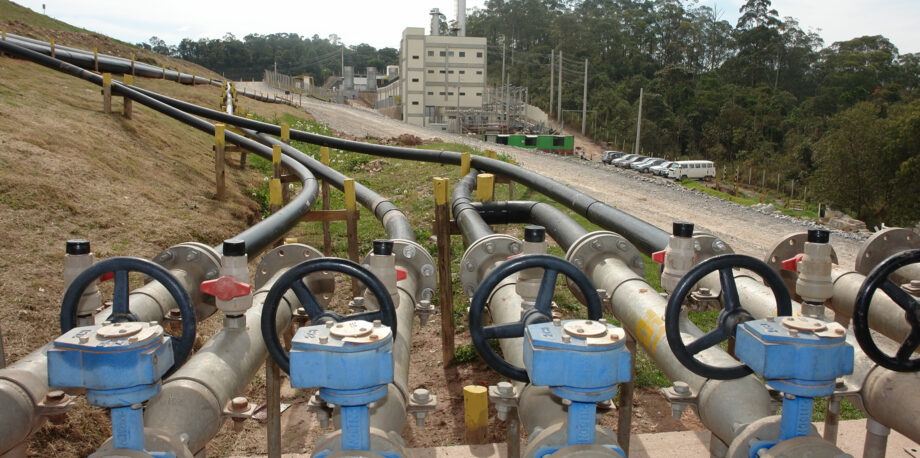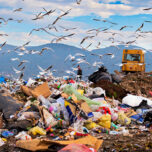April 16, 2020 — Editor’s note: As we continue to share stories of importance to the long-term well-being of people and our planet, we acknowledge the profound challenges the COVID-19 pandemic poses today. We express our solidarity with all of humanity and commit to using the lessons we learn through this crisis to help shape a more positive future together.
Over the course of 20 years, a molecule of methane heats the planet by 84 times as much as a molecule of carbon dioxide. It’s one cause of the climate crisis — and more methane now hangs in Earth’s atmosphere than at any time since monitoring began, according to the U.S. National Oceanic and Atmospheric Administration (NOAA).
A preliminary tally, with final numbers slated for release by November, it’s no surprise given expert projections: More and more methane pours into the air each year, with the trend line set to keep climbing in coming decades as societies generate more garbage and companies produce more unconventional natural gas.
But a new study in the journal Environmental Research Communications finds that the world could defy that forecast and cut methane emissions using existing tools. By bringing already available technologies and techniques into wider use, the researchers say, we could avoid nearly 40% of the methane the world is projected to emit by 2050.
The researchers, a team from the International Institute for Applied Systems Analysis, estimate that without new action, methane emissions will grow by about 3 million metric tons (3.3 million tons) annually. Add that up year after year, and we’re staring down global methane emissions in 2050 that are 30% higher than in 2015.
“Mitigating methane will partly require different strategies and policies than those used to eliminate carbon dioxide from our energy systems,” paper co-author Lena Höglund Isaksson, an environmental economist at the International Institute for Applied Systems Analysis, wrote in an email to Ensia. While energy from fossil fuels is one source of methane, people also put the gas into Earth’s atmosphere when disposing of trash, growing rice, raising farm animals and doing other activities.
Improve Waste Management
Yard waste and uneaten food decomposing in landfills vent methane into the air, so the study finds lots of potential in improved garbage management. The researchers estimate that separating waste by source, with better recycling and schemes to capture energy from some trash — plus a ban on organic waste in landfills — could help the world avoid emitting 778 million metric tons (858 million tons) of methane that would otherwise make its way into the air between now and 2050.
Repair Leaks
Ultimately, fossil fuels will also need to be phased out, Höglund Isaksson writes. But in the meantime, the study finds that we could slow the growth of methane emissions by taking steps such as implementing programs to detect and repair leaks in oil production and the extraction and transportation of natural gas. Coal mines could consistently implement degasification and improve ventilation, and oil drillers could try to recover associated gas. Such steps — with leakage detection and repair being the biggest — could prevent 2.35 billion metric tons (2.57 billion tons) of methane emissions by 2050.
Modify Agricultural Practices
Methane emissions from agriculture, the study finds, will be the hardest area for technical improvements. Rice cultivation’s footprint could decrease if farmers used alternative hybrids, improved water management and added materials to improve soil properties. These steps could avoid 335 million metric tons (370 million tons) of emitted methane by 2050. Livestock breeders could continue efforts to raise more productive animals: If farmers could use fewer cows to produce the same amount of milk, for example, that would cut back on emissions. This approach could yield different emissions results in cows, pigs, sheep and other livestock.
To sketch a picture of global methane emissions, the researchers used a model that sums up the estimated emissions from different sources, including landfills, beef cattle, dairy cows and oil refineries. The researchers had to make some assumptions where data were incomplete, and there’s always uncertainty about projections of the future, although the model aligns pretty well with other estimates of future “business as usual” methane emissions.
“Getting methane emissions anywhere close to zero will be hard, especially in agriculture. The paper highlights many priorities and places to start,” writes Rob Jackson, a Stanford University Earth systems scientist who was not involved in the study, in an email to Ensia. Technical fixes identified in the paper as providing relatively large impact with relatively low cost include modifications of waste and wastewater management and fossil fuel production practices.
The new study concludes that technical solutions to cutting back on methane won’t be enough to solve the problem. People might have to change their diets, for example, and governments may need to improve health care and boost farmers’ access to credit.
To keep methane in line with international goals — and keep global temperatures from exceeding 1.5 °C (2.7 °F) above preindustrial conditions — we’ll need social and political change to reduce the amount of methane we generate. While we work toward that, technical solutions can start to make a difference.
Related Posts
Ensia shares solutions-focused stories free of charge through our online magazine and partner media. That means audiences around the world have ready access to stories that can — and do — help them shape a better future. If you value our work, please show your support today.
Yes, I'll support Ensia!


